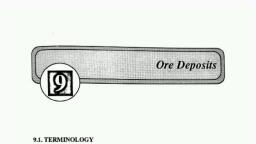Page 1 :
WEATHERING, Unit-2
Page 2 :
Weathering, • The disintegrating or decaying effect of weather, climate and, atmospheric agencies on rock., , • Rocks are formed in different conditions but they undergo different, , physical chemical conditions unlike he original when they are exposed to, earth surface., , • It is important for the formation of soil, laterite, ground water, occurrences, and some economical mineral deposits, , • Weathering doesn’t involve transport., • The weathered materials accumulate to form a soft surface layer called, as mantle of waste or Regolith
Page 3 :
Weathering, Erosion and Denudation, • The process of mechanical decay and/or chemical disintegration is called, as WEATHERING. Rocks become weak, less cohesive and fractured, , • These weathered materials are easily dislodged by different natural forces, like gravity, wind, river, glaciers etc. This process of removal of material, from the source origin is called EROSION., , • When weathered materials are eroded away from the rock surface a fresh, unweathered part of the surface gets exposed to further weathering, process, which is called as DENUDATION.
Page 4 :
Factors affecting Weathering, 1., 2., 3., 4., 5., , Climate, Topography, , Texture, structure and mineralogical composition of rock, Vegetation cover, Time
Page 5 :
Climate, • Climate determines whether mechanical disintegration or chemical, decomposition will predominate and the speed of the process, • Types on the basis of temperature, 1. Tropical – uniform temperature, 2. Temperate- highly variable, 3. Polar- mostly below 10 c, • Types on the basis of rainfall, 4. Arid- high temperature low rainfall, 5. Semiarid- rainfall 25-50cm, 6. Semi humid- rainfall 50-105, 7. Humid- 105-210, 8. Dessert- Average annual rainfall = potential evaporation, • Physical disintegration is high in arid climates, • Chemical decomposition is high in humid climate
Page 6 :
2. Topography, • Higher the relief grater it is exposed to weathering agents, • Higher slopes provides pace to the weathering processes, , 3. Texture, Structure, mineralogical composition, • Structural features like presence of joints, cracks, fractures, fissures in igneous rocks,, bedding planes in sedimentary rocks, foliations in metamorphic rocks facilitates, maximum weathering, , •, •, •, •, , Textural characteristics defines the strength and hardness of the rock., , Finer the grains of the rocks the more it is susceptible to weathering, , Harder the rock, the less is the degree of weathering, The major factor is the mineralogical composition. Different minerals are having, different degree of stability. Which is tabled by Goldich, called as Goldich stability, series.
Page 8 :
4.Vegetation cover, • Surfaces protected with vegetation cover obviously need more force, to be weathered., , • But the penetration of roots through the fractures and joints of rocks, makes it more prone to weathering. On the other hand the organic, acids released accelerates the chemical weathering processes., , 5. Time, • Longer the time it is exposed to the weathering agents the more the degree of, weathering
Page 9 :
Agents of weathering, •, •, •, •, •, •, •, , Water – river or ground water, , Wind, Gases like carbon dioxide, Acids, , Gravity, Variation of temperature, Biological organisms
Page 10 :
Types of weathering, 1. Physical weathering, 2. Chemical weathering, 3. Biological weathering
Page 11 :
Physical Weathering, 1. Variation in temperature:, • Differential expansion and contraction in rock produces layers of weathered, surfaces, , • In polymineralic rocks different minerals behave differently to the temperature, changes, , • Rock composed of different coloured minerals also experience differential, , temperature, 2. Variation in Pressure, • Most of the rocks are formed beneath the surface with high temperature and, pressure. When these rocks are exposed to the surface the temperature and, pressure varies spectacularly to which the rocks result expansion., • Simultaneously removal of the overlying rock material by weathering creats a, pressure disturbance to which rocks adjust by expanding .
Page 12 :
Exfoliation, • Originates due to differential experience of temperature and pressure through, , different parts of the rock, • Core of a rock experiences less than that of surface which results, the surface to expand more and fall of temperature results in compaction, • Similarly the removal of overburden through weathering, a rock mass expands to, cop-up with the pressure change, through which, joints, and fissures are developed which divide, the rock, into layers, • The simultaneous action results decrease in, internal cohesion and binding forces., • Causing the rock to be pealed or flaked up into, layers called as exfoliation, • Exfoliation in large boulders causes spheroidal, weathering.
Page 13 :
3.Growth of crystals, • Growth of crystals through the pores, joints, fissures through ppt. by, groundwater or surface water carrying dissolved minerals creates, internal stresses which further decreases the internal cohesion and, helps the rocks to disintegrate., , 4. Freezing of water, , • Simultaneous freezing and melting of water in the interstices results, in variation of internal stresses which causes the rock to be, fragmented easily
Page 14 :
Chemical Weathering, 1. Hydration, • This is the most powerful chemical weathering process done by water., Water molecules are injected into the interstices of the molecules of, other minerals. Due to absorption of water minerals cause internal, expansion and bringing about the decomposition of minerals., , • The most common and important is decomposition of feldspars into, clay mineral kaolinite.
Page 15 :
2. Hydrolysis, • In some cases instead the whole water molecule, the ionic part of water i.e., H+ and OH- ion bring about the decomposition., , • It depends on the acidity of the water that how much the water will be, helpful for weathering.
Page 16 :
3. Oxidation, • Chemical combination with oxygen is known as oxidation., • Combination of water and oxygen produces hydroxides of different, elements which are the leached out., , • The ferromagnesian minerals like pyroxenes and amphiboles rapidly, undergo oxidation under normal atmospheric conditions
Page 17 :
5. Carbonation, • Its helpful to dissolve limestone and formation of clay from feldspars, • Rain water dissolves some of the atmospheric carbon dioxides, , forming carbonic acid and that is capable of reducing certain minerals, , • Carbonation is most active with the rocks containing alkali earth, metals like Ca, Na etc.
Page 18 :
5. Solution, • Some of the minerals gets dissolved by water and thus removed., • Pure water is not a good solvent., • Salt minerals like halite, sylvite are more prone to solution while, sulphates and carbonates are less prone.
Page 19 :
Biological Weathering, • Bio-physical Weathering, 1. Plant roots penetration through the rock joints, fissures loosens the rock, 2. Insects and burrowing animals provide suitable exposure of the rock, surfaces by loosening the soil cover, , • Bio Chemical Weathering, 3. Certain group of bacteria algae breaks down silica directly, 4. Acids secreted by plant roots, 5. Animal excretions, 6. Formation of chemically active acids from dead animals decaying












































